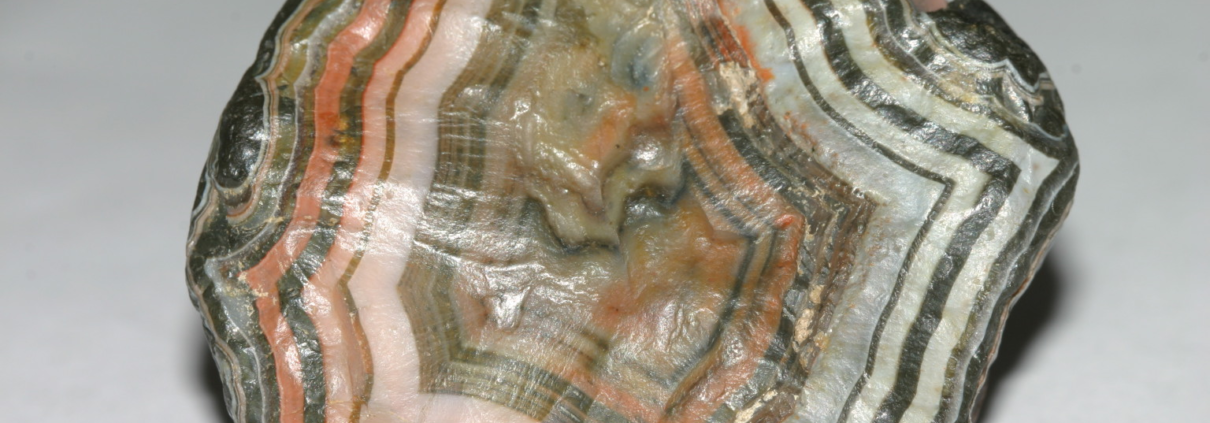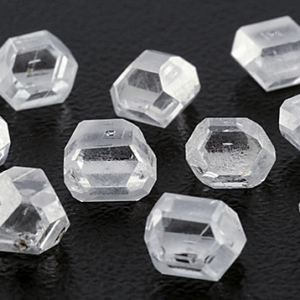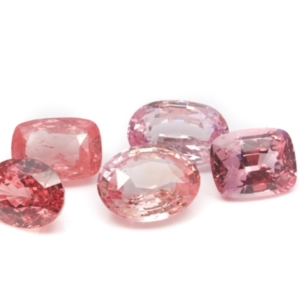Fairburn Agate
Fairburn Agate is a unique and highly prized variety of agate known for its distinctive banding patterns and vibrant colors. Typically found in the Fairburn area of South Dakota, this semi-precious gemstone is characterized by its intricate, concentric banding in shades of red, orange, yellow, and white. The bands often exhibit a striking contrast, making Fairburn Agate particularly attractive for collectors and jewelers. Its formation involves the slow deposition of silica-rich solutions into cavities within rocks, resulting in the beautiful layered structures that define the agate.
 Cut and Polished Fairburn Agate from Pringle, South Dakota (icollector.com)
Cut and Polished Fairburn Agate from Pringle, South Dakota (icollector.com)
In geology, Fairburn Agate holds significant importance due to its unique formation process and its ability to provide insights into the geological history of the region where it is found. The agate’s intricate banding patterns reveal information about the environmental conditions during its formation, including the presence of volcanic activity and the subsequent cooling periods. This makes Fairburn Agate an invaluable specimen for studying sedimentary processes and the mineralogical changes over geological time scales.
In gemology, Fairburn Agate is highly valued for its aesthetic appeal and rarity. Its vibrant colors and complex patterns make it a sought-after material for crafting jewelry and decorative items. Each piece of Fairburn Agate is unique, contributing to its desirability among collectors. The gemstone’s durability and the ease with which it can be polished further enhance its significance in the gemological community. Consequently, Fairburn Agate not only holds geological interest but also commands considerable attention in the world of gemstones and jewelry.
Contents
- Geological Background
- Geographical Distribution
- Primary Locations Where Fairburn Agate is Found
- Geological Characteristics of These Regions
- Physical Characteristics
- Color Variations and Patterns
- Unique Features That Distinguish Fairburn Agate from Other Types of Agates
- Uses and Applications
- Uses in Jewelry and Ornamentation
- Other Practical Applications in Industry or Art
Geological Background
 Fairburn Agate Home (fairburnsuperagate.com)
Fairburn Agate Home (fairburnsuperagate.com)
Formation and Composition of Agates
Agates are a type of microcrystalline quartz, primarily composed of silicon dioxide (SiO₂). They form within volcanic and sedimentary rocks through the deposition of silica from groundwater in cavities or fractures. This process often takes millions of years and involves several stages:
- Initial Cavities Formation: Cavities or voids in rocks, often created by volcanic activity, serve as the initial spaces where agates can form. These cavities might be gas bubbles in lava or spaces left by the dissolution of mineral nodules.
- Silica-Rich Solution Infiltration: Groundwater, rich in dissolved silica from surrounding rocks, percolates into these cavities. Over time, the silica starts to precipitate out of the solution and deposit on the walls of the cavity.
- Layered Deposition: The silica deposits in layers, forming concentric bands. Variations in the chemical composition, temperature, and pressure conditions during the deposition lead to different colors and patterns, resulting in the distinctive banding seen in agates.
- Completion of the Agate: Over prolonged periods, the cavity fills entirely with silica deposits, forming the solid agate. The final appearance of the agate is influenced by trace minerals, which impart different colors to the bands.
Specific Conditions Required for Fairburn Agate Formation
Fairburn Agate, known for its particularly vibrant colors and striking banding patterns, forms under specific geological conditions prevalent in the Fairburn area of South Dakota:
- Geological Setting: Fairburn Agates are primarily found in the White River Group, a sequence of sedimentary rocks from the Oligocene epoch. The region’s unique geological history, including volcanic activity and sedimentary processes, provides the ideal setting for agate formation.
- Silica-Rich Environment: The presence of abundant silica in groundwater is crucial. This silica likely originates from the weathering of volcanic rocks and other silica-rich minerals in the region.
- Cavity Formation: The Fairburn area has numerous cavities within the rock formations, often created by gas bubbles in volcanic rocks or the dissolution of minerals. These cavities are essential spaces where agates can form.
- Stable Conditions Over Time: The formation of Fairburn Agates requires long periods of stability, allowing for the slow and gradual deposition of silica layers. Variations in temperature and chemical conditions during deposition contribute to the unique color patterns.
- Trace Minerals and Impurities: The presence of trace minerals, such as iron, manganese, and other elements, influences the coloration of Fairburn Agates. These minerals are introduced into the silica-rich solutions and become incorporated into the agate structure, creating the characteristic red, orange, yellow, and white bands.
The combination of these specific geological conditions makes Fairburn Agate a distinct and highly prized variety of agate, celebrated for its beauty and geological significance.
Geographical Distribution
 Top Shelf Full Face Fairburn Agate (icollector.com)
Top Shelf Full Face Fairburn Agate (icollector.com)
Primary Locations Where Fairburn Agate is Found
Fairburn Agate is primarily found in the following locations:
- Fairburn Area, South Dakota: The type locality for Fairburn Agate is the region surrounding the town of Fairburn in the Black Hills of South Dakota. This area is the most renowned source and has historically produced some of the finest specimens.
- Black Hills Region, South Dakota: Beyond the immediate vicinity of Fairburn, the broader Black Hills region also contains deposits of Fairburn Agate. This area extends into parts of Nebraska and Wyoming, where similar geological conditions exist.
- Nebraska and Wyoming: Certain locations in Nebraska and Wyoming, particularly those near the borders with South Dakota, also host Fairburn Agate. These areas share geological characteristics with the Black Hills region, allowing for the formation of these unique agates.
Geological Characteristics of These Regions
The regions where Fairburn Agate is found share several geological characteristics that are conducive to the formation of these distinctive agates:
- Sedimentary Rock Formations: The primary host rocks for Fairburn Agate are sedimentary formations, particularly those of the White River Group. These formations date back to the Oligocene epoch and are characterized by layers of volcanic ash, siltstone, and claystone, providing the necessary cavities and silica-rich environments for agate formation.
- Volcanic Activity: The presence of ancient volcanic activity in the region is crucial. Volcanic eruptions produced ash and other materials that contributed to the silica-rich conditions necessary for agate formation. Gas bubbles in volcanic rocks created cavities that later became filled with silica deposits to form agates.
- Silica-Rich Groundwater: Groundwater in these regions is enriched with silica, derived from the weathering of volcanic rocks and other silica-bearing minerals. This silica is essential for the formation of the microcrystalline quartz that constitutes agates.
- Weathering and Erosion: The regions have undergone significant weathering and erosion, exposing the agate-bearing layers. These processes not only help to uncover the agates but also contribute to the formation of the cavities where the agates develop.
- Stable Geological Conditions: Long periods of geological stability allowed for the slow and steady deposition of silica layers within the cavities. This stability is key to the development of the characteristic banding patterns seen in Fairburn Agates.
- Trace Mineral Availability: The regions contain various trace minerals that influence the coloration of the agates. Elements such as iron, manganese, and other impurities become incorporated into the silica layers, creating the vibrant red, orange, yellow, and white bands typical of Fairburn Agate.
These geological characteristics collectively create the ideal conditions for the formation of Fairburn Agate, making the regions of South Dakota, Nebraska, and Wyoming prime locations for finding these beautiful and geologically significant gemstones.
Physical Characteristics
 fairburnsuperagate.com
fairburnsuperagate.com
Color Variations and Patterns
Fairburn Agate is renowned for its striking color variations and intricate banding patterns, which make it one of the most visually appealing types of agate. The key features include:
- Color Variations:
- Red: One of the most dominant colors in Fairburn Agate, often caused by iron oxide impurities.
- Orange and Yellow: These hues are also common, typically resulting from different concentrations of iron oxides and other trace minerals.
- White: White bands often occur between colored layers, providing sharp contrast and enhancing the visual appeal.
- Pink, Brown, and Black: Less common, but these colors can appear due to variations in mineral impurities and geological conditions during formation.
- Patterns:
- Concentric Banding: The most characteristic pattern of Fairburn Agate is its concentric bands, which create a target-like appearance.
- Wavy or Chevron Patterns: Some specimens exhibit wavy or chevron-like banding, adding to their uniqueness.
- Fortification Patterns: These resemble the layout of ancient fortifications or walls, with angular and branching bands.
Unique Features That Distinguish Fairburn Agate from Other Types of Agates
Fairburn Agate possesses several unique features that set it apart from other types of agates:
- Vibrant and Contrasting Colors: The intensity and variety of colors in Fairburn Agate are particularly striking. The sharp contrast between the vibrant reds, oranges, yellows, and whites is less commonly seen in other agates.
- Complex Banding Patterns: While many agates have banding, the complexity and clarity of the bands in Fairburn Agate are exceptional. The patterns are often more intricate and well-defined compared to those in other agate types.
- Geological Origin: Fairburn Agate’s specific geological origin in the Black Hills region of South Dakota, Nebraska, and Wyoming contributes to its distinct characteristics. The unique combination of volcanic and sedimentary processes in this area influences the agate’s formation and appearance.
- Fortification Banding: The presence of fortification banding, which mimics the appearance of medieval fortresses, is a distinctive feature not commonly found in other agates.
- Transparency and Opacity: Fairburn Agate often displays a mix of transparent, translucent, and opaque bands, creating a dynamic visual effect. This variation in light transmission through the bands adds depth and complexity to its appearance.
- Rarity and Collectibility: Due to its limited geographical distribution and the specific conditions required for its formation, Fairburn Agate is relatively rare. This rarity, combined with its aesthetic qualities, makes it highly sought after by collectors and gem enthusiasts.
- Durability: Like other agates, Fairburn Agate is composed of hard, durable quartz, making it suitable for various applications, including jewelry and decorative items. Its resistance to scratching and wear enhances its value as a gemstone.
These physical characteristics and unique features make Fairburn Agate a standout variety in the world of agates, prized for its beauty, rarity, and geological significance.
Uses and Applications

Uses in Jewelry and Ornamentation
Fairburn Agate is highly prized for its striking appearance and unique patterns, making it a popular choice in various forms of jewelry and ornamentation:
- Jewelry:
- Cabochons: Fairburn Agate is often cut and polished into cabochons, which are then used in rings, necklaces, bracelets, and earrings. The smooth, domed shape of cabochons highlights the intricate banding and vibrant colors.
- Beads: Agate beads are used in creating beautiful, multi-colored necklaces and bracelets. The durability of agate makes it ideal for beadwork.
- Pendants: Large, visually stunning pieces of Fairburn Agate are frequently set as pendants, showcasing their natural beauty.
- Cameos and Intaglios: The hardness and fine grain of Fairburn Agate make it suitable for detailed carvings, including cameos and intaglios, which are used in brooches, rings, and other jewelry items.
- Ornamentation:
- Decorative Objects: Fairburn Agate is used to craft various decorative items such as paperweights, desk ornaments, and small sculptures.
- Inlays and Mosaics: Thin slices of Fairburn Agate are used as inlays in furniture, boxes, and other decorative pieces. The vibrant colors and patterns add an element of luxury and uniqueness to these items.
- Collectibles: Due to its rarity and aesthetic appeal, Fairburn Agate specimens are collected and displayed as natural art pieces. Collectors often seek out high-quality, uncut specimens for their natural beauty.
Other Practical Applications in Industry or Art
While the primary uses of Fairburn Agate are in jewelry and ornamentation, it also finds applications in various other fields:
- Art:
- Sculpture and Carving: Artists and sculptors use Fairburn Agate to create intricate carvings and sculptures. The hardness and fine grain of agate allow for detailed work, and the natural patterns add an organic aesthetic to the pieces.
- Cabinetry and Furniture: In high-end furniture making, Fairburn Agate can be used as decorative panels or inlays, adding unique and luxurious elements to cabinets, tables, and other pieces.
- Healing and Metaphysical Uses:
- Crystal Healing: Some people use Fairburn Agate in crystal healing practices, believing it has metaphysical properties that promote emotional balance, grounding, and stability. It is often carried as a talisman or placed in specific areas to harness its supposed energies.
- Meditation Tools: Due to its calming and centering properties, Fairburn Agate is used in meditation practices. It is believed to help focus and enhance spiritual growth.
- Educational and Scientific Uses:
- Geological Study: Fairburn Agate specimens are valuable in geological studies and education. They help students and researchers understand sedimentary processes, mineralogy, and the geological history of the regions where they are found.
- Museum Displays: Museums often include Fairburn Agate in their exhibits to showcase the beauty and diversity of mineral specimens. These displays educate the public about geological processes and the natural history of gemstones.
- Home Décor:
- Tabletops and Countertops: In high-end interior design, polished slices of Fairburn Agate can be used as tabletops or countertops, creating stunning, one-of-a-kind surfaces that highlight the natural beauty of the stone.
- Wall Art: Large agate slices or panels are sometimes mounted and framed as wall art, serving as focal points in interior spaces.
Fairburn Agate’s combination of beauty, durability, and rarity makes it a versatile material with a wide range of applications, from fine jewelry to decorative art and practical uses in various industries.



Leave a Reply
Want to join the discussion?Feel free to contribute!